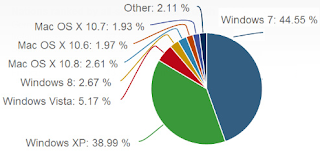Four months after rollout, Microsoft has achieved an anemic 2.67% market share for Windows 8. Growth does not even keep up with natural attrition.
In the month of February, according to Net Applications, Windows 8 gained 0.4% of the desktop market, moving from 2.26 to 2.67%. In comparison, Windows 7 had a market share of over 9% after four months of public availability. A growth rate of 0.4% is absolutely horrendous, and — if we assume that PCs are replaced every five years — actually below the natural attrition/replacement rate. If growth of 0.4% wasn’t bad enough, it’s also worth pointing out that it’s down from 0.5% in January — yes, Windows 8 adoption is slowing down. Windows 7, after a small dip last month, actually gained market share in February.
It’s a bitter pill to swallow, but Windows Vista actually enjoyed faster growth than Windows 8 — and we know all too well how the Vista story played out. Despite selling Windows 8 at a massively discounted price of $40 for three months (it’s now $200), and sales boosts from Black Friday and Christmas, it’s clear that Windows 8 has failed to take off. Short of giving away Windows 8 for free, there isn’t a whole lot that Microsoft can do — and even then, there are still millions of consumers and business customers that are perfectly happy with Windows 7 and leery of Windows 8′s Metro Start screen.
Windows and Office are cash cows for now, but the desktop market has started to contract — slowly at first, but it will accelerate. With the mobile market exploding, Windows Phone failing to grab significant market share on the smartphone, and minuscule tablet market share for Windows 8, it doesn’t look good for Microsoft.
Microsoft Slashes OEM Bundle Price to $30 from $120
ExtremeTech reports Microsoft cuts the price of Windows 8 and Office 2013.
In a double whammy of bad news, it seems that Microsoft has been forced to cut the price of Windows 8 and Office 2013 licenses to spur the adoption of Windows 8 — and Samsung, citing lack of consumer interest, has pulled its Windows RT tablet from Germany and “additional European countries.”
According to the Wall Street Journal’s anonymous sources, Microsoft has been offering a dual pack of Windows 8 and Office to OEMs for $30 since late February, for touchscreen devices under 10.8 inches. The previous price was $120.
We still don’t know exactly how many touch-enabled Windows 8 devices are actually being used by consumers, but the mere fact that Microsoft hasn’t shared any figures — either in general, or specifically for its Surface tablets — is a strong indicator that things aren’t going to plan. The only real indication we’ve had is from retailers such as Newegg, which said that sales of Windows 8 tablets had been very slow, and that most Windows 8 devices sold had been laptops or tablets.
Which leads us neatly onto the second tidbit: Samsung is pulling the Windows RT Ativ Tab out of Germany and “additional European countries” (Samsung hasn’t yet specified which ones). This follows on from Samsung’s decision to not release the Ativ Tab in the US, citing a lack of consumer interest and confusion over what Windows RT actually is.
Moving forward, we should also remember that Microsoft is working on Windows Blue, which will reportedly be very cheap — or possibly free. It isn’t yet clear whether Blue will be a standalone version of Windows that you can buy off the shelf, or the code name for Microsoft’s internal shift towards annual releases, instead of every two or three years. It is possible that Microsoft’s slashing of Windows 8 and Office license costs is simply a precursor to Windows Blue. Considering how Windows and Office bring in the lion’s share of Microsoft’s profits, though, this certainly seems like a dangerous game for Microsoft to be playing.
Should some form of OpenOffice ever gain a big corporate following in the US, it will be the end of Microsoft as we know it. With the new emphasis on tablets and phones, perhaps the end is here regardless.
Mike “Mish” Shedlock
http://globaleconomicanalysis.blogspot.com
